It was already hot and sunny by the time we emerged from Modestine this morning. The flowering acacia beneath which she'd been parked last night had shed so many blossoms over her she looked as if she'd been to a wedding!
No point in wasting time. Let's get straight to the point so that we can get to bed. Venice is everything it's cracked up to be, plus some! We've had a brilliant day and have walked our legs off up to our knees at least if not to our elbows. We arrived back at the campsite exhausted around 7pm and now that the last dregs have been squeezed from our wine box we are attempting to do some sort of justice to Venice in the pages of our blog.
The bus to Venice stops on the road passing the campsite and for a euro each we were driven directly onto the island - so much easier and cheaper than trying to find a space in one of the car parks. Immediately we were plunged into the heart of the city where we wandered the little streets and alley ways, edged by canals with little stepped bridges linking the hundreds of islands that constitute Venice. There are countless bridges, all picturesque but requiring fit knees so don't attempt it unless you are in good shape. We seem to have crossed most of them at least once today.
The vaporetti or water buses can take you along the canals, out to the islands and pretty well anywhere you want to go. A day pass costs 12 euros. Today we didn't bother as there was so much we wanted to explore on dry land. On our next visit we will ensure we get full value from the tickets.
The light in Venice is wonderful. Our first view of the Grand Canal was stunning in that it really looked exactly like a Canaletto painting with the water a bright azure blue reflecting the sky, offset by the colour rendered buildings with their dark green shutters along its edge. No matter where we looked a new perspective opened to us. The gondolas plied their way along the narrow canals, manoeuvring past each other, the gondoliers wearing their striped shirts and straw hats. Okay, it's for the tourists but the atmosphere is just so pleasurable. The greatest joy is that there is absolutely no traffic so you can walk in complete safety anywhere you like. Even bicycles are absent. It's strange at first not to hear the constant sound of car engines. All traffic goes by water. Parcels are delivered, the postman comes, goods supplied to the shops, building materials, the dustmen, all these are water borne arriving on little barges or motor launches. Indeed the waterways are incredibly busy and it is tempting just to stand on one bridge for ages watching the constant flow of boats passing beneath.
 Grand Canal, Venice
Grand Canal, Venice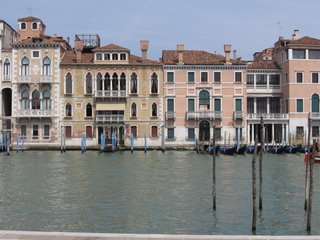 Water Front, Venice
Water Front, Venice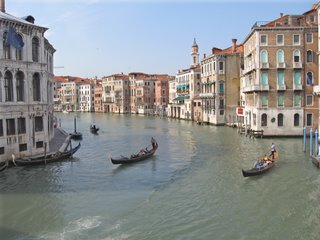 Gondolas on the Grand Canal, Venice
Gondolas on the Grand Canal, Venice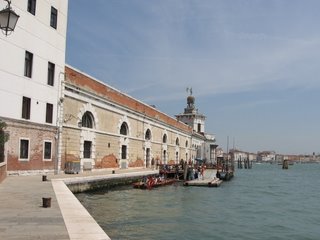 Customs House, Venice
Customs House, Venice Canal scene, Venice
Canal scene, Venice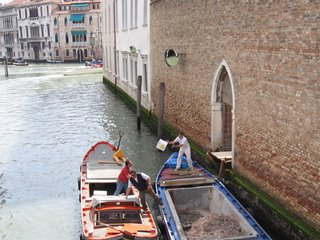 All deliveries come by boat, Venice
All deliveries come by boat, Venice Canal crowded with boats, Venice
Canal crowded with boats, VeniceThe narrow streets, frequently edged along one side by a canal and invariably interrupted by bridges, are lined with little tourist shops selling masks, glassware, jewellery, cakes and pasta in every possible shape, size and colour.
The masks of course are a speciality of Venice and although many are q bit kitsch, they are rather attractive and some have an immense charm. The good quality ones are made from papier-mâché before being smoothed and decorated. Shops specialise in selling these, plus all the costumes and hats to go with them for special carnival events.
 Masks for sale, Venice
Masks for sale, VeniceVenetian glass can be very beautiful and very expensive. A small wineglass can easily cost 65 euros! There are cheaper examples, but then they look it. Glass jewellery is very popular but often a bit tacky. Much of the glassware is made on the neighbouring island of Murano but there are glassblowing furnaces in the city that can be visited on a cooler day.
Of course there are countless bars, terraces and restaurants, each looking a very tempting place for a cool drink on a hot day. At lunchtime we were fortunate to find a little restaurant well away from the main flow of tourist traffic where we had vegetable tagliatelli with lashings of olive oil and a carafe of wine at a very inexpensive price. We were given an aperitif into the bargain. At a nearby table three gondoliers in their stripy tee shirts were having their lunch. We waited with bated breath for their pudding to arrive. Would one of then stand up and call to the waitress "just one cornetto"? Alas no. But if the restaurant was good enough for them, it was certainly an excellent place for us to have selected for our own lunch.
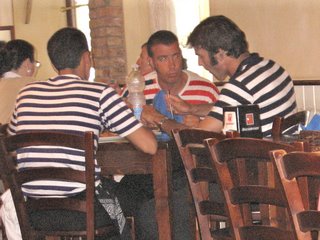 Gondoliers at lunch, Venice
Gondoliers at lunch, VeniceDuring our meal we helped an American couple search the floor around their table for a missing wrist watch. They never found it but were fairly philosophical about its loss. We fell into conversation when they stated, rather obviously, they were from America and promptly apologised for their president! They told us we were lucky to have Blair, they'd have him in preference to Bush any day! This has happed to us several times over recent months. Perhaps Americans who travel are more sensitive to the way the rest of the World tends to see the influence American politicians try to exert.
Most of the day we have simply been wandering the streets and soaking up the atmosphere. After lunch however, we made our way to St.Mark's Square and the Doge's Palace. This is at the very heart of the maze that is Venice. The place where everyone eventually ends up before plunging off into the network of streets and waterways to become hopelessly lost again. Even Ian, map in hand, became completely disorientated, complaining that the map was designed as if the canals were the routes to follow but frequently this was impossible as there were no pavements beside them.
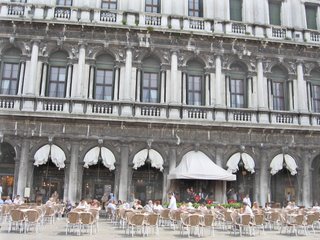 Café Florian, St. Mark's Square, Venice
Café Florian, St. Mark's Square, VeniceSt. Mark's square is full of pigeons, tourists and hot glaring sunlight. At the far end is the cathedral church of St. Mark with a long queue of hot red tourists waiting to see inside. Beside it stands the brick campanile, a reconstruction of the original which collapsed dramatically in 1902. Neil and Jeev visited the cathedral of St. Mark recently and described it as "a bit of a chav cathedral with lots of bling" So we decided instead to visit a few of the lesser churches, wonderfully cool and dark inside and with some excellent marble sculptures and 16th century paintings. In particular we visited St. Giovanni in Bragora, the local church of Antonio Vivaldi who was born nearby, baptised in the church and was later organist there.
 St. Mark's Cathedral, Venice
St. Mark's Cathedral, Venice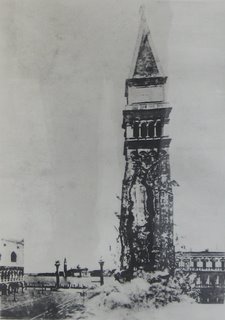 Original Campanile in St. Mark's Square photographed by chance as it fell, Venice
Original Campanile in St. Mark's Square photographed by chance as it fell, Venice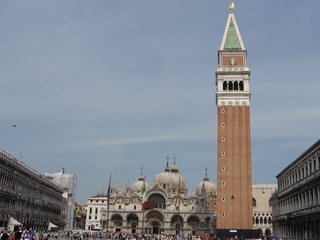 Replacement campanile in St. Mark's Square, Venice
Replacement campanile in St. Mark's Square, Venice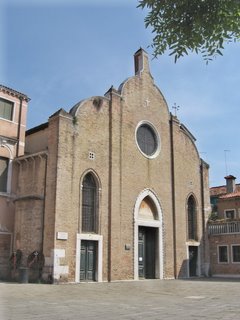 Church of St. Giovanni in Bragora, Venice
Church of St. Giovanni in Bragora, VeniceBehind St. Mark's cathedral stands the Doge's Palace. Again we did not fancy queuing in full sunshine to see around, but the exterior was quite beautiful with patterned brickwork in shades of rose with white marble window facings.
 Doge's Palace, Venice
Doge's Palace, Venice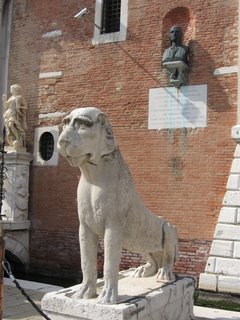 Statue of the Dog(e), Venice
Statue of the Dog(e), VeniceIan discovered a whole new series of bridges for us to climb as he lead the way to the furthest tip of one of the islands to see the arsenal where the ships that helped to make Venice such a major power were constructed. When we arrived it was to discover that it is still held by the military today and is a forbidden area.
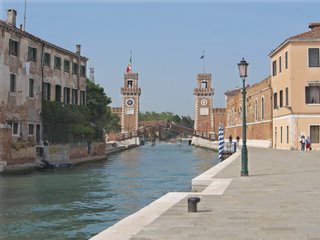 Arsenal, Venice
Arsenal, VeniceBy now we were exhausted and just about as far from the bus station as it is possible to be in Venice. Furthermore, we were completely lost in a maze of narrow streets, dead ends and countless bridges. On our wanderings we discovered the Bridge of Sighs, the Rialto Bridge and a young man making the most wonderful music on a collection of wine glasses! This offered us a welcome break as we stopped to listen, fascinated at his skill and the sheer beauty of the sounds produced by running wet fingers around the rims of the 40 or so glasses of differing sizes.
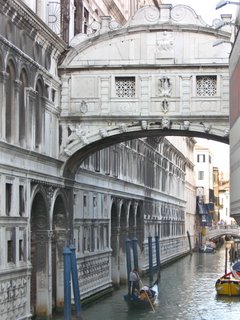 Bridge of Sighs, Venice
Bridge of Sighs, Venice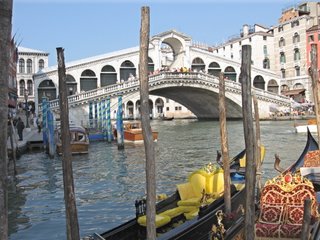 Rialto Bridge, Venice
Rialto Bridge, Venice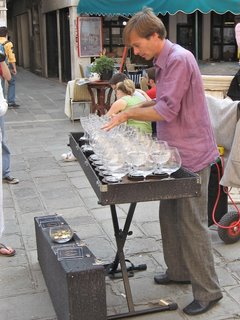 Top glass musician, Venice
Top glass musician, VeniceEventually we did find our way back to the bus station with 20 minutes until our bus was due to leave. It was already waiting and we climbed aboard in time to get the last couple of available seats. By the time it left it was packed to the gunnels and everyone was hot and weary. We kept pinching ourselves to stay awake, praying we would recognise the campsite when we reached it. When we finally rejoined Modestine we were fit only to collapse into chairs under the cool trees and watch the red sunset gradually fade into darkness. Last night we got bitten by insects. Tonight we are covered in citronella oil and Ian has even tucked his trouser legs into his socks so hopefully we've escaped. It's the first place we've been bothered with them.
Thursday 18th May 2006, Serenissima, Oriago, near Venice
This morning we took the bus to Padua, 25 kilometres along the banks of the Brenta river which flows between Venice and Padua, passing right beside the camp site. Along the route are numerous 16th -18th century villas originally owned by Venetian patricians as their summer residences. They looked very attractive standing along the river bank, some with old, rustic statues or large baroque entrance gates. Some, like the one at the entrance to the campsite, have seen better days and are now rather dilapidated but others have been turned into luxury hotels or are still privately owned.
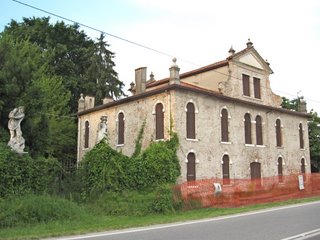 Villa at Serenissima campsite, Oriago
Villa at Serenissima campsite, Oriago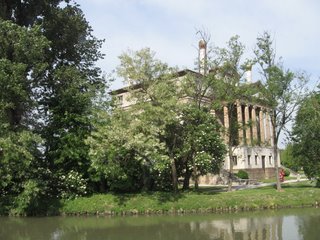 Villa of Malcontenta – a lady unhappily exiled from Venice
Villa of Malcontenta – a lady unhappily exiled from VeniceOne, at Stra, looked quite magnificent and rather than being a villa, had more the air of a palace. In size it looked as if it could possibly rival Blenheim!
The bus dropped us just outside Padua's city walls – by via Vecchio Gasometro (Old Gasometer Street)! Six years ago we found ourselves stuck for several days in Padua. Then we visited most of the major galleries and churches, including the Scrovegni Chapel with the wonderful frescos by Giotto. So this was really a nostalgia trip with little time to do more than enjoy the ambiance of the town.
 Scrovegni Chapel (1303), Padua
Scrovegni Chapel (1303), PaduaWithin the city walls it is indeed a very pleasant place, steeped in history and full of atmosphere. We wandered the arcaded streets around the old law courts, now used as council offices, where the market is held each day with the food stalls tucked well in under the arcades to protect the meats, cheeses and fish from the sun. At the back of the arcades are rows of tiny shops selling speciality pastas, fish and eels, charcuterie, cakes and elaborate, expensive, hand-made chocolates.
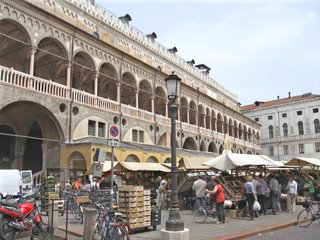 Market place and old law courts, Padua
Market place and old law courts, Padua Speciality pasta shop, Padua
Speciality pasta shop, Padua Sausages and more, Padua
Sausages and more, PaduaUnlike Venice, traffic flows through the streets of the old town with all the consequential congestion. Bikes are the main form of transport – sturdy vehicles to cope with the cobbled roads. They are parked all over the city and are a constant hazard when crossing any of the little side streets.
Being a University town Padua is a lively place, particularly around the University buildings. We glanced in at the Palazza Bo, the main courtyard to the university established in 1222. In the street students were celebrating the success of one of their colleagues in defending his thesis and gaining his degree. The poor student was dressed in a smart suit, wearing a wreath of laurels, and was obliged to run the gauntlet of his colleagues whilst they all beat and kicked him as he passed. (On our last visit proud parents did not seem to be around and the student was in his underwear!)
 Palazza Bo with plaques to former university students, Padua
Palazza Bo with plaques to former university students, Padua Successful student about to earn his laurels, Padua
Successful student about to earn his laurels, PaduaThe cathedral was closed when we arrived but we visited innumerable churches, all refreshingly cool, all with the remains of beautiful frescoes, their altars backed by early oil paintings. Outstanding amongst these was of course the 14th century church of St. Anthony of Padua, died 1231, to whom some Christians turn as a last resort when things have been lost.
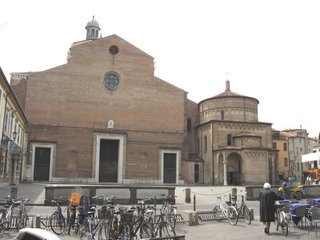 Cathedral and Baptistry, Padua
Cathedral and Baptistry, Padua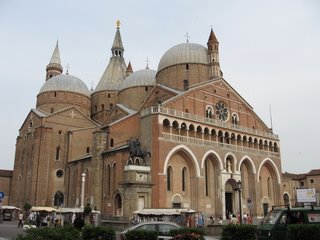 Basilica of St. Anthony of Padua
Basilica of St. Anthony of PaduaThe church is quite plain on the outside, being brick built in the 13th century. Inside however the building is huge and lavishly ornate with the sepulchre holding the remains of the saint in a highly elaborate marble tomb where queues of people waited to lay their hands on it and pray. Frescoes, marble, paintings, richly decorated altar pieces and chalices adorned every corner of the church. As we made our way around the apse we were amazed to hear "Land of Hope and Glory" on the church organ accompanying someone singing an Italian hymn to the tune. It gave us a strange feeling of being very close to home despite our surroundings. Maybe nearly ten months of seeing the marvels of Europe are stirring the odd moment of nostalgia in us!
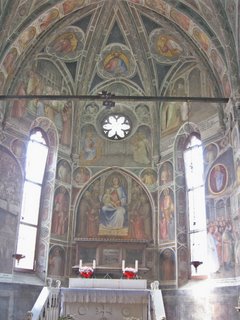 Frescoes in St. Anthony's, Padua
Frescoes in St. Anthony's, Padua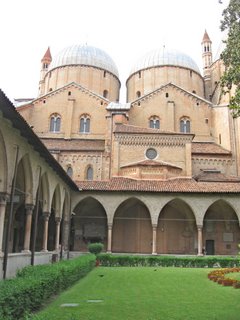 One of the three cloisters of St. Anthony's, Padua
One of the three cloisters of St. Anthony's, PaduaThere is a side chapel where the church relics are held. We had presumed St. Anthony was safely tucked inside his massive, ornate sarcophagus but we now discovered some bits of him were on display in various golden reliquaries. Never having seen authenticated holy vocal chords or a holy tongue before we joined the stream of pilgrims filing past. As if these were not sufficiently fascinating to queue for, we were rewarded with the additional sight of the saint's lower jawbone and teeth very nicely set in a solid gold casket. So we now have a mental image of what is left of St. Anthony inside his tomb patiently listening to granny asking him to help her find her missing dentures, while he has his own concerns about where his own teeth might be and how he had come to lose his voice!
In front of the church of St. Anthony stands a bronze equestrian statue by Donatello, 1447, depicting the Venetian commander Erasmo da Narni, known as Gattamelata (tabby cat) because of his agility and cunning. The horse is massively powerful and it is the first of its size to have been cast in Italy. During the day we also saw the house where Galileo lived when he was a lecturer at the university, and the remains of a Roman circus. Otherwise the day was spent wandering the streets and looking at the countless architectural treasures of Padua that surrounded us.
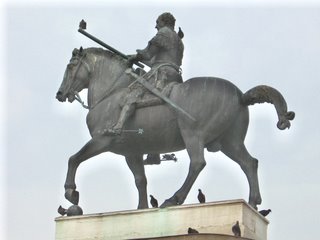 Erasmo da Narni on his enormous horse, Padua
Erasmo da Narni on his enormous horse, Padua House of Galileo, Padua
House of Galileo, Padua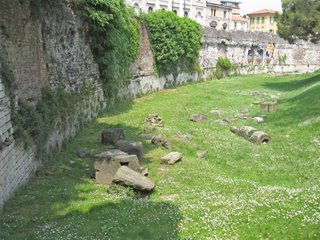 Remains of Roman circus, Padua
Remains of Roman circus, Padua Some of the 78 statues in the Prato della Valle, Padua
Some of the 78 statues in the Prato della Valle, Padua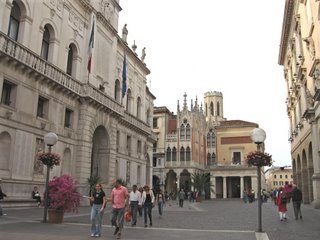 Caffè Pedrocchi, Padua
Caffè Pedrocchi, PaduaPadua has so much it is impossible to try to do it any sort of justice after a visit of a few hours. Unseen today but previously visited are its art gallery with an outstanding collection of works by Italian artists, its botanical gardens and its circular anatomy theatre – the oldest in the world, dating from 1594. Bodies were taken from graves and smuggled in on a barge along a river that flowed beneath the theatre. The anatomy students would gather around on steeply ranked seats to observe the dissection. If there was any risk of a raid – such activities being completely illegal at the time – the body would be lowered back into the barge and the floor laid over the top. An orchestra would be standing by and the students could pretend they were at a completely different type of event!
Being on our feet all day yesterday and again today is exhausting. Churches offer the opportunity to sit down in the cool for a few minutes, but by the time we were on the bus back to the campsite we were both exhausted. We nearly missed our stop as we were fighting sleep at the time.
Now we learn that there is a transport strike in Venice tomorrow. There will be no transport to get us there and no vaporetti to take us around the canals. This is a bit of a blow and we will now need to think through a different strategy. We had planned to move on Saturday as it is expensive staying in this part of Italy so we don't want to waste tomorrow hanging around waiting for the strike to end.
Friday 19th May 2006, Serenissima, Oriago, near Venice
Well we have not done a great deal today but it has been very pleasant and relaxing. It was gone 1am last night by the time we had written up the blog and inserted all the pictures. So this morning we didn't wake until 9am by which time the heat of the day was starting to penetrate to Modestine's interior.
We have now discovered there is very little shade on our pitch. We have also discovered the slightly surreal joy of having a fridge, an efficient fan, double glazing and heat reflective blinds in the middle of a field a thousand miles from home! Modestine really is rather a marvel.
It has been baking today. Far too hot to venture out on Hinge and Bracket until around 4.30 this afternoon. So we have made the best of being marooned on the edge of Venice by a transport strike. We have made full use of a couple of the campsite's washing machines so we are now spotless for future travels. We chased the shade around our pitch until lunch time when it disappeared completely for a while. Then we "holed-up" in Modestine with iced water, our electric fan and all the blinds down - an oasis of cool in a parched and baking landscape. We caught up on correspondence and updating the blog. Around 4pm we let Hinge and Bracket out of their travel bags and took them for a scamper around the countryside.
The campsite is beside the Brenta canal, roughly midway between Venice and Padua. With no buses today the road was particularly busy so we turned off as soon as we could to cross a little wooded bridge across the Brenta to the calmer, pleasant residential area of Oriago, following a route Ian devised from his map through open countryside where maize wheat and poppies grew on the flat plan as far as the eye could see. Our route took us along beside canals and over little wooden hump-backed bridges, passing in front of several of the picturesque villas mentioned yesterday. We'd hoped to visit Villa Widmann Rezzonico Foscari but arrived as it was closing.
Exploring the back streets in an attempt to return to the campsite without using the dangerously busy main road, we discovered a tiny supermarket where we purchased materials for supper and bought a bottle of wine for half the price charged for similar wines on the campsite.
By 7pm we were testing it out after taking a cool shower and feeling much fresher. As darkness fell the nightlife arrived. Gnats and mosquitoes we keep at bay with an assortment of citronella products. The bright blue lights of the fireflies darting around us as darkness falls we are only too delighted to enjoy.
Friday 20th May 2006, Serenissima, Oriago, near Venice
Today we returned to Venice. Strikes were finished and with our 12 euro freedom of Venice cards we enjoyed a restful day seeing the city from the water as we hopped on and off the water buses as the fancy took us. They are very slow, cumbersome and noisy, frequently crowded and invariably battered and rusty. They are part of the Venetian way of life however and a necessary requirement for crossing the city without walking miles to use the bridges and follow the canals. Individual trips are very expensive but our freedom tickets covered not only the boats but the bus between the campsite and Venice. We also used the boats to explore further, visiting a couple of the islands out in the lagoon, though not bothering with the Lido. The whole joy is to escape cars and we could see car ferries taking vehicles across there.
We seem to have done the water equivalent to the city ring road, travelling right around Venice before heading out into the lagoon to the island of Murano. This is a pleasant place, full of shops selling Venetian glass of varying quality. The cheaper end of the market we suspect is actually imported from China. There are furnaces where one can watch glass-blowing as ornaments are formed. Venetian glass is rather curious in that some is really awful and tacky whilst other pieces can be superbly designed and made. These are expensive of course but beautiful for those who appreciate such things. We found it interesting to look around one of the showrooms but there was nothing there we personally would wish to own. Indeed, some of the more elaborate chandeliers and mirrors we found far too glittery and "pretty" for our taste though they were attracting a lot of attention from some American tourists.
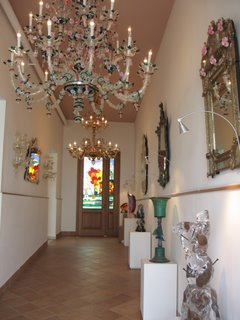 Glass mirrors and Chandeliers, Murano
Glass mirrors and Chandeliers, MuranoLater we found the church of San Pietro Martire where all the chandeliers were in glass having been especially commissioned. Here they were in a more suitable setting and were quite acceptable. We also discovered the church of Santi Maria e Donato, brick-built Romanesque with a beautiful galleried apse, a very elaborate 12th century mosaic floor and a modern glass font and glass crucifixion.
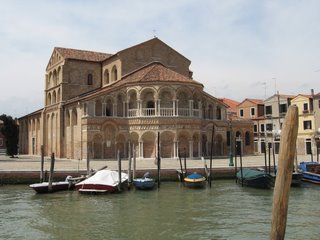 Santi Maria e Donato, Murano
Santi Maria e Donato, MuranoVenetian glass has been made on the island of Murano since the 13th century. Prior to that it was produced in Venice itself but the fire risk from the furnaces necessitated moving the industry out of the city.
On Murano there is one main canal, crossed by a single bridge, and several smaller ones. Less crowded than Venice with smaller boats and bridges it reminded us very much of Comacchio though grander and more geared to tourism.
 Murano
Murano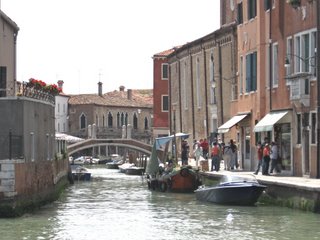 Murano
MuranoIn Venice, on the lagoon, and around the smaller islands everything is transported by water. At Murano we passed little greengrocer stalls and bakers floating on the main canal. In Venice we saw a wedding couple and out on the lagoon we passed a funeral on its way to the cemetery.
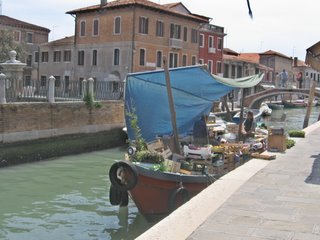 Floating greengrocer, Murano
Floating greengrocer, Murano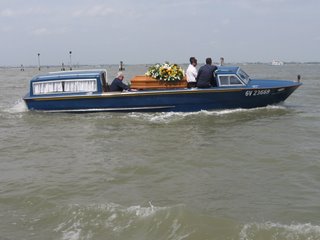 Death in Venice
Death in VeniceThere is an island specifically designated as the cemetery and here Venetians are brought, usually on their last but one boat ride to be interred in the ground or walled up in a stone box in the necropolis. Most do not stay here for ever though. After a certain length of time their remains are gathered together and they are transported by boat beyond the lagoon where they are laid to rest on a reef beneath the sea composed entirely from their decomposed ancestors! A few, such as Stravinsky, Diaghilev, Ezra Pound and several Russian princesses or other special cases are allowed to remain on the island. All this macabre business struck us as a curious way of spending an hour so we caught the ferry to the cemetery island, known as San Michele, and discovered a haven of peace and quiet. We wandered amongst the tombstones lying in rough grass and wild flowers where the only sound was made by the birds in the cypress trees. An elaborate brick wall surrounds the cemetery with gateways for boats to moor with their consignments of one way ticket holders. From within the graveyard we had glimpses of boats and ferries plying their way across the lagoon – the world of the living so close to that of the dead.
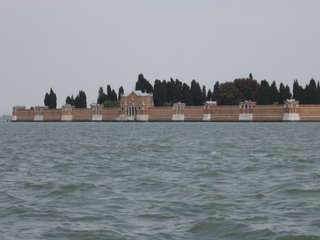 Cemetery island of San Michele
Cemetery island of San Michele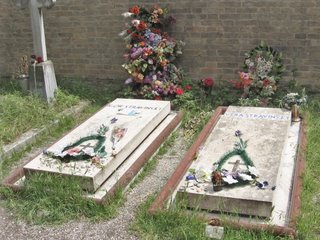 Decomposing composer, Stravinski's grave, San Michele
Decomposing composer, Stravinski's grave, San Michele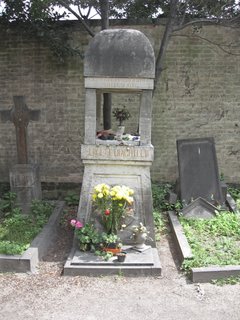 Tomb of Diaghilev, San Michele
Tomb of Diaghilev, San Michele Cloisters, San Michele
Cloisters, San MicheleIn a corner of a foreign field we found tombstones of visitors who had died in Venice, mainly in the 19th century. Here we discovered a lady born in Gittisham, Devon. To add to our curiosity, her epitaph was written in French. Something for us to follow up in the archives or the library once we return to Exeter perhaps!
 Mary Wilhelmena Marker Pernot from Gittisham, San Michele
Mary Wilhelmena Marker Pernot from Gittisham, San MicheleWe made our way back to the landing stage and took the water bus back to Venice, passing close beside the port full of Greek ferries loading vehicles onboard for the journey down to Crete. We have had several twinges of longing since we have been here, wondering whether we should abandon our plans to go on to Hungary and head for Xania instead. We have such delightful memories of hiring a car some years back and touring around Crete. However, we also recall some of the steep mountain roads. Fine in a Twingo but not ideal for Modestine, good as she is, so we will leave that for now.
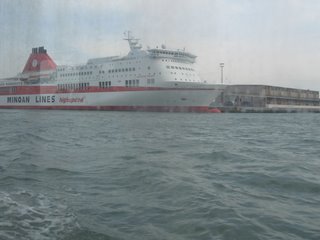 Car ferry to Crete, Venice
Car ferry to Crete, VeniceBack in Venice we took the water bus up the Grand Canal right through the centre of the city as far as the station, looking at all the buildings on one side. Then we caught another one back again, looking at the opposite bank.
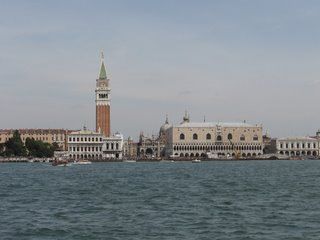 San Marco and the Doge's Palace from the Grand Canal, Venice
San Marco and the Doge's Palace from the Grand Canal, Venice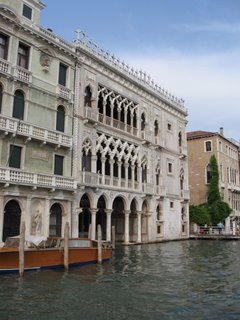 Ca' d'Oro, Venice
Ca' d'Oro, Venice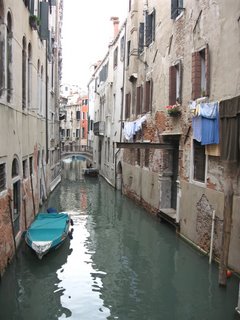 Backwater with washing in Venice
Backwater with washing in VeniceAt the Rialto Bridge we got off and treated ourselves to more modest ice creams than those we'd indulged in while in Florence, spent an hour on the internet at a cyber shop where they didn't actually ask to see our passports, and made our way to the bus station for the free bus ride home. We ate supper outside in the gathering darkness with the fireflies again but have been driven inside by moths and gnats where Ian is working out our onward route for tomorrow. It is tempting to go via Slovenia and Croatia but we promised Mike Maguire we'd visit Graz so we will probably head there, cutting across Austria. At least we'll have a brief respite from language struggles there until we get into Hungary.
